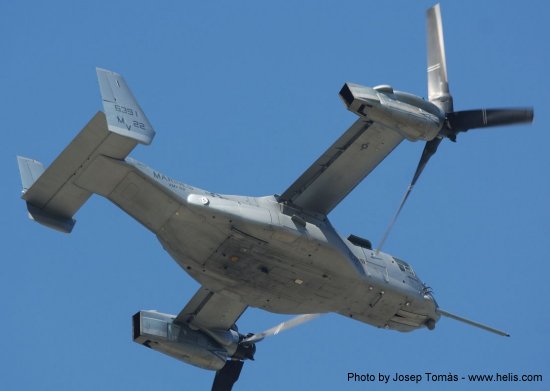Bell/Boeing, 1999 - An independent British -- U.S. study jointly assessed the potential for the
V-22 to meet current and future U.K. vertical airlift requirements. The requirements for this study were based on the Royal Navy's Future Amphibious Support Helicopter program, as well as the U.K.'s recent Strategic Defence Review.
The Defence Evaluation Research Agency, or DERA, the privatized research arm of the Ministry of Defence, located in Farnborough, United Kingdom, along with TRW, Inc. of Fairfax, Va., evaluated the V-22s operational capability versus that of conventional helicopters using three scenarios. The high-resolution combat results models demonstrated the potential benefits to the UK of three key tiltrotor attributes: speed, range and survivability.
The Defence Evaluation Research Agency, or DERA, the privatized research arm of the Ministry of Defence, located in Farnborough, United Kingdom, along with TRW, Inc. of Fairfax, Va., evaluated the V-22s operational capability versus that of conventional helicopters using three scenarios. The high-resolution combat results models demonstrated the potential benefits to the UK of three key tiltrotor attributes: speed, range and survivability.

"The superior speed of the tiltrotor dramatically improved the rate at which troops, weapons systems and supplies were delivered to the landing zones," said John Buyers, Bell Boeing program manager at Naval Air Station Patuxent River, Md. Speed also reduced exposure to air defense threats and increased aircraft and payload survivability in the simulations, he explained.
Increased mission radius capability allowed the assault ships to operate well away from land-based anti-ship missile batteries and naval mines according to the report. On land V-22s permitted deeper operations and enhanced survivability as mission planners routed the aircraft around known air defense threats.
The study also indicated that the V-22 had utility in performing eight ancillary missions, in particular ship-based Airborne Early Warning, Aerial Tanker platform and Strategic Self-Deployment.
The first scenario evaluated was an amphibious assault performed by the Royal Marines as part of a U.S.-led coalition force in the Persian Gulf. In this scenario, the performance of the V-22 was evaluated solely against that of the medium-lift helicopter. DERA and TRW determined that this would be the most likely competitor for the V-22 in the assault role. The study concluded that in the critical first six hours of the simulated assault mission, the V-22 delivered 41 percent more combat power to the landing zones than the medium-lift helicopter in this short-range scenario. At longer ranges the models showed the V-22 able to deliver the complete landing force in 15.7 hours less time, a 50 percent advantage, over the medium-lift helicopter.
The second scenario was a regional conflict inside NATO. In this scenario, the use of support rotorcraft in a number of possible fleet mixes was examined. The scenario showed that an all V-22 force of 27 aircraft could perform all the missions 45 percent faster than the base case of 40 helicopters (i.e., 16 heavy-lift, 8 medium-lift and 16 light-lift helicopters). For a raid on the enemy tank division headquarters, the speed of the tiltrotor allowed mission completion with 39 percent to 47 percent less time exposure to air defense threats. The increased exposure of the helicopters to surface-to-air threats, along with the inherent hardness of the V-22, meant that the helicopter alternatives suffered twice as many combat losses/casualties and had fewer aircraft remaining for subsequent operations.
The third scenario looked at a U.K.-led multi-national force tasked with conducting a non-combatant evacuation operation in Western Africa. With an equal number of three tiltrotors or helicopters, the speed of the tiltrotor allowed all civilians to be evacuated in the shortest period of time; overcoming even the larger passenger capacity of the heavy lift helicopter. The medium or light-lift helicopter would require almost two days to complete the same mission that the V-22 tiltrotor could do in less than 20 hours.
In every scenario the speed, range and survivability of the tiltrotor allowed it deliver more combat power faster, more effectively and with fewer combat losses than would helicopters.
If only V-22s were used to meet the military needs of these three scenarios, DERA modeling showed that based on Strategic Defence Review operational requirements, between 42 and 62 V-22s would be required for the UK.
The first production MV-22 made its public debut by landing on the Pentagon parade grounds in September, providing orientation flights to several congressman and defense officials during an all day static display of the Bell XV-15 tiltrotor.
The Osprey will provide a multi-mission, multi-service versatility and capability to U.S. forces by beginning with USMC initial operational capability in 2001. It is capable of carrying 24 combat-equipped personnel or a 15,000-pound external load. It also has a strategic self-deployment capability with 2,100 nautical mile range with a single aerial refueling. Its vertical/short takeoff and landing capability allows it to operate as a helicopter for takeoff, hover and landing. Once airborne, the engine nacelles rotate forward 90 degrees, converting the V-22 within 20 seconds into a high-speed, high-altitude (25,000 feet), fuel-efficient turbo-prop aircraft.
